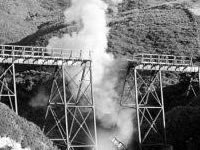What happened that day?
See historic events for any day of the year by entering the date below. Why not try your birthday?
Kiwi of the Week
Today in History

1944 Poll tax on Chinese immigrants abolished
The Finance Act (No. 3) abolishes the poll tax, introduced in 1881, which is described by Minister of Finance Walter Nash as a 'blot on our legislation'.
A public meeting held in Dunedin in 1871 had called unanimously for a ban on further Chinese migrants. As work on the goldfields became harder to find, anti-Chinese prejudice increased. With the Chinese Immigrants Act 1881, New Zealand followed the example of Canada and the Australian colonies and imposed entry taxes on Chinese immigrants. A ‘poll tax’ of £10 a head was introduced, and ships arriving in New Zealand were restricted to one Chinese passenger per 10 tons of cargo. In 1896 this ratio was reduced to one passenger to 200 tons of cargo, and the poll tax was increased to £100.
Organisations emerged to oppose Chinese immigration during the late 19th and early 20th centuries, including the Anti-Chinese Association, the Anti-Chinese League, the Anti-Asiatic League and the White New Zealand League.
The poll tax was waived by the minister of customs in 1934, but it was not repealed until 1944. By then other countries had abandoned it. In 2002 the New Zealand government officially apologised to the Chinese community for the suffering caused by the poll tax.
Other ways in which Chinese were discriminated against included:
- From 1907 all arrivals were required to sit an English reading test.
- From 1908 Chinese who wished to leave the country temporarily needed re-entry permits, which were thumb-printed.
- From 1926 permanent residency was denied to Chinese.
- Until 1936 Chinese were denied the old age pension.
Image: Poll tax certificate (Te Ara)
Internal links

1951 Belmont viaduct blown up
The towering Belmont railway viaduct, which bridged a deep gully at Paparangi, northeast of Johnsonville, Wellington, had been first built in 1885 by the Wellington and Manawatu Railway Company (WMR). Unused since 1937, when the Tawa Flat deviation was opened, it was demolished by Territorial Army engineers.
The original wooden viaduct formed part of the WMR line between Wellington and Longburn, near Palmerston North, which was completed in November 1886. Standing 125 feet (38 m) high and 341 ft (104 m) long, this was the largest wooden trestle bridge in New Zealand, and one of the largest in the world at the time. Its construction required 212,000 superficial feet (64,600 metres) of kauri timber.
In 1903 (in part because of concerns over the risk of fire) it was replaced by a steel viaduct, which was built around the wooden structure without requiring any closures of the line. In 1908, when the WMR was bought by the government, its line - including the Belmont viaduct - became part of the newly completed North Island Main Trunk Line.
By the 1920s, though, the steep, twisting line between Wellington and Johnsonville was unable to handle the demands of main trunk traffic. Work on the Tawa Flat deviation out of Wellington, which included two long tunnels passing under Cashmere, Newlands, Paparangi and Grenada, began in 1927; it was opened to freight traffic in 1935 and to passenger trains in June 1937. The old WMR line was then cut off at Johnsonville and became a suburban commuter line, operated from July 1938 by New Zealand's first electric multiple units.
The Belmont viaduct, now bypassed, was left to rust for 14 years. In October 1951, due to concerns about public safety, the decision was made to demolish the derelict structure. Territorial Army engineers were given the job as a training exercise. On 15 December, after standing for 66 years, the Belmont viaduct was destroyed by explosive charges. Today, its original concrete abutments are all that remains in the regenerating bush of Seton Nossiter Park.
Image: Detail from blowing up Belmont railway viaduct slideshow














